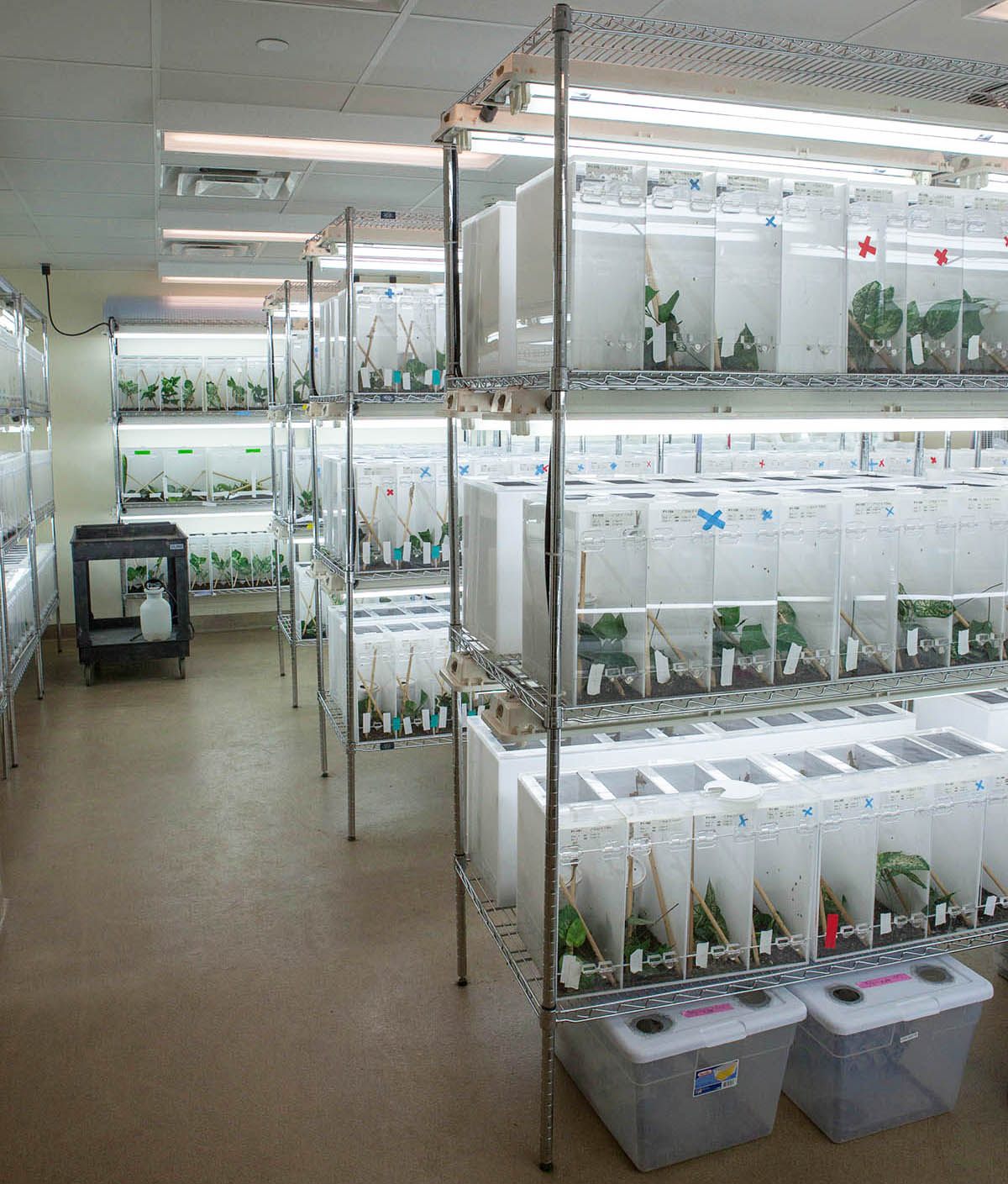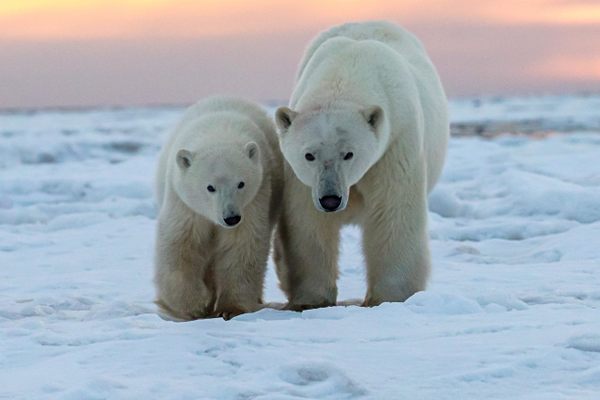At an Underground Harvard Lizard Colony, Scientists Study Speciation
Several hundred brown anoles are helping researchers discover how new species come to be.

The small propeller plane vibrates alarmingly as it takes off from the main airport in the Bahamas. It’s carrying unusual cargo: besides the eight human passengers, there’s a large white cooler, over three feet long. Inside, in dozens of round plastic deli containers, are 120 live lizards, collected over the previous days on another Bahamian island. They range in size from less than three inches long (the smallest adult females) to over seven inches, including the tail, for the biggest males, and are varying shades of rust, brown, beige, and gray. These are lizards in the Anolis genus—Anolis sagrei, to be exact, also known as brown anoles—and ultimately they’re bound for a large, underground room full of specially made acrylic tanks at Harvard University that houses hundreds of other lizards.
One of the goals of that lizard colony—and the reason for expeditions like this one to bring back live anoles—is to quantify an especially tricky aspect of evolutionary biology: How do you determine when two groups of similar animals are becoming separate species?

Besides the Bahamas, brown anoles are found in Cuba, Jamaica, and on many Lesser Antilles islands. The brown anoles on different islands can vary in appearance or behavior, but they’re still all considered one species, because they look similar and the assumption is that they can breed and produce viable, fertile offspring. However, within that outcome—the production of fertile offspring—there is some nuance that researchers are trying to tease out. Do lizards from different islands, when paired in captivity, produce fewer offspring than two lizards from the same island? Do those offspring have lower survival, or are they less fertile? And is there any hesitancy towards mating with a lizard from another island?
A “yes” to some of these questions—and the accompanying data—might indicate that these separated anoles are on diverging paths, ones that could eventually lead to different species. The key, says Jonathan Losos, a professor of evolutionary biology at Harvard who oversees the lizard colony, is establishing whether reproductive isolation is occurring: that is, if lizards from different islands have less success reproducing than lizards from the same island. But, as he notes, “it’s actually very difficult to quantify reproductive isolation, because you have to measure whether species will mate with each other, and what the outcomes of those matings are.”

This is easy with fruit flies, for example, which reproduce quickly and can be stored in a relatively small space. But with a terrestrial vertebrate like a lizard, the challenges increase drastically. Losos’ specialty is Anolis lizards; they’re “a classic case of evolutionary diversification,” he says. “And yet, we don’t know how the speciation process works.”
Before the lizards can be flown back to Harvard and paired off, of course, they need to be caught. Hence the chartered plane in the Bahamas with three field assistants—including the author of this story—and Colin Donihue, a postdoctoral fellow at Harvard and the leader of this expedition. (A family of four, heading to their vacation house, was also along for the ride).

As the plane passes over the myriad islands of the Bahamas, the pilot points out one owned by Johnny Depp, and another by Tyler Perry. But the destination is a long island, called Long Island, whose claim to fame is that it has one of the world’s deepest blue holes. It’s sparsely settled, with only one long main road that traverses its narrow, 80-mile length. And it’s chock-full of anoles. (Johnny Depp’s island probably is, too, but Donihue didn’t bother inquiring whether it was okay to catch lizards there).
The basic tool for catching lizards is a thin, extendible carbon-fiber pole up to 16 feet long. At its tip, Donihue hand-ties a small loop of yellow string in a specific way, such that it will tighten around the neck of the lizard in question—providing its operator can get it over the lizard’s head, that is. Fortunately, Donihue is something of an expert at so-called “lizard noosing.” The length of the pole lets him keep his distance from the lizards so they don’t get spooked while he finagles the noose over their heads. Some anoles, however, will still flee the loop of yellow string (“noose-shy,” in lizard-catching parlance); others think it’s food and bite at it, leaving the string moist with saliva. But a good chunk of the time, Donihue gets the noose around a lizard’s neck and, with a quick jerk, has it dangling from the end of the pole. (Its neck muscles protect it from injury). Donihue brings in the lizard and loosens the string from its neck while the anole bites at his fingers. Each one goes in a soft cloth bag that Donihue suspends from his belt, like trophies.

After Long Island, Donihue will head to a third island to collect another batch of lizards; then, the cooler will be shipped overnight to Florida, where it will pass through customs and then be sent on to Massachusetts, where Donihue will be waiting. Before flying down to the Bahamas, Anthony Geneva showed me around the room where those lizards would eventually end up. He’s also a postdoc in the Losos lab, and he takes the lead on running the colony.
Stepping into the room, with its bright white fluorescent lighting, the first thing to notice is the temperature. It’s a balmy 84 degrees F, and humid—just how the lizards like it. Banks of illuminated tanks line the walls and shelving units. Of the 1,000 or so lizards housed here, the vast majority are brown anoles, with some select samples of other Anolis species, including a few huge, bright-green creatures with large pink dewlaps, the flaps of skin beneath the necks of male anoles that they use to warn off other males or woo potential mates. In each clear plastic tanks, which are about a foot tall and half a foot wide, are some sticks leaning haphazardly, some fake plastic leaves, dirt, and between one and six lizards. (Fiercely territorial adult males can’t be housed together, but multiple newly hatched lizards or females can coexist peacefully). In the tanks where a female and male are paired off, there’s also a Styrofoam cup filled with vermiculite—the perfect substrate for females to lay their eggs in. Once a week, Geneva, Donihue, and a team of students and lab workers sift through the vermiculite, removing any eggs they find to an incubator.

So far, Geneva says, they have found some differences in fertility when looking at inter-island pairs. “Some crosses produce far fewer fertile eggs than others,” he says. Now, he’s starting to test the offspring whose parents come from different islands to see how their fertility varies; he expects to have that data sometime this summer.
Ultimately, the outcome of this experiment could give us direct insight into how new species come to be, says Losos. He’s leaving his post at Harvard to head up a new biodiversity initiative in St. Louis; he says that once this experiment wraps up in mid 2018 and the data are analyzed, he’ll decide whether it makes sense to set up a new colony of lizards in Missouri. As to whether these brown anoles will, in fact, eventually become separate species, we’ll have to wait a bit longer to find out. Geneva says that some of the lizards on different islands have been separated for millions of years, and they’re not yet considered separate species. So speciation might take at least a few million years more. (Evolutionary) time will tell.





















Follow us on Twitter to get the latest on the world's hidden wonders.
Like us on Facebook to get the latest on the world's hidden wonders.
Follow us on Twitter Like us on Facebook